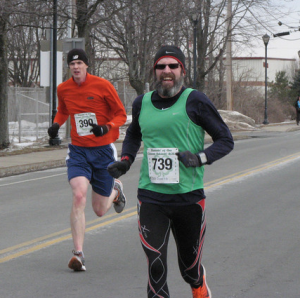The recent migration of middle-distance Olympian Nick Symmonds from Nike to Brooks and the saga of where Olympic distance runner Kara Goucher would wind up after leaving Nike (She chose upstart women’s clothing manufacturer Oiselle http://www.outsideonline.com/fitness/bodywork/in-stride/Kara-Goucher-Leaves-Nike.html?utm_source=twitter&utm_medium=social&utm_campaign=tweet) has gotten me thinking about marketing in the running industry. Here’s the thing: I’m all for companies such as Nike, New Balance, Adidas, Brooks, Oiselle, etc. supporting the livelihoods of professional runners even though when you look closely at the business model it doesn’t appear to make any sense. As a sport, running is like soccer in the United States during the 1970s and early 1980s: everyone was doing it, but nobody was watching it. Running faces a similar problem. Where I live in the capital region of upstate New York on any given weekend starting during early spring, there are multiple races in which to test one’s mettle. The Hudson Mohawk Road Runners Club’s fall half-marathon was closed out in half a day (I missed the sign up because I was running…grrrrrr.). There are numerous clubs and many, many, group runs during the week. Only the most cynical or unobservant could possibly conclude that the sport of running is not amazingly vibrant and healthy at the participant level. At the professional level – the level that needs fans and followers – the rhetoric that surrounds the sport is one of crisis. The typical professional runner makes $16,000 a year. There is a labyrinthine bureaucracy supervising competition that makes it difficult for professionals to innovate. Ever notice that a professional runner’s shorts and singlet are almost completely free of advertising? Professionals such as Nick Symmonds would like that to change. What the elite branch of the sport needs is a league that fans could follow and that would have runners representing cities in a series of competitions that would lead up to some type of title match. Author and announcer Toni Reavis has written several times about this proposal, as well as other ways of growing a fanbase. I’m going to tackle some of these issues in subsequent posts (Why, for example, does every athlete sponsored by Nike or Adidas, etc., always wear the same design and color of uniform? It’s bizarre and it makes running even more difficult to follow for the inexperienced fan).
Today, however, I have a proposal that might actually undermine efforts to support professional runners – sorry. It’s more of an appeal to the pragmatic business acumen of the major running shoe companies, although there is really no legitimate reason why my proposal and continued support of professionals should not comfortably co-exist. OK, here it goes: I race more often than Galen Rupp and a lot more often than a professional marathoner such as Ryan Hall. Obviously, the quality is not the same (duh), but this is more about contact. The runners that you are trying to sell shoes to probably don’t even see the elites when they are featured in the same race. Regular, everyday, runners at races have little idea of what shoes the elites are wearing, and have even less information about how those shoes perform. Let me rectify that. I race frequently and would race even more frequently with your support. I often get into conversations at races with fellow runners about shoes, training, etc., and find that I can be quite the brand ambassador without really intending to. Even though Hoka One One has just signed a major sponsorship deal with Leo Manzano earlier this week, I think that I would also be a good fit. I can’t stop endorsing the Bondi 2 – it has allowed me to up my mileage without getting injured. I can go on a long run and then do it all again the next day. This is quite a revelation for the masters runner. I would be happy to talk up Hoka One One at the various races I attend. When I run races, I am not so far out in front that other runners can’t see my shoes or what I am wearing. You’ll get maximum brand exposure, because I spend more time on the course. I am fast enough, however, for some to wonder if “It must be the shoes.” (See what I did there, Nike?) I think this sponsorship deal would be fairly straightforward. I need some free shoes, kit, my entry fees, and travel expenses (Travel, at this point is not going to be too expensive. I am still completely local – I even run to some of my local races. I do, however, have aspirations of traveling to the National Cross Championships someday.). What you get in return is brand exposure that runners at local races will actually see and an enthusiastic advocate of your products. True, Hoka One One is going to have to get a racing flat out pronto, but since Leo joined that is something that is being fast tracked. (I have to admit that I am very excited about the prospect of Hoka One One making spikes. Hoka foam under the spike plate sounds wonderful…) OK, running shoe companies, if you are interested in my proposal, contact me on my blog and I will get right back to you.
After having made the claim that my status as an average masters runner makes me a good candidate for a new model of sponsorship, I went out last weekend and blew my amateur status. I finished second in a local road race and was happy to discover a fifty-dollar Visa gift card in my award bag – sweet. I went out and treated the family to ice cream and there was actually some money left over (I live in New York…).
